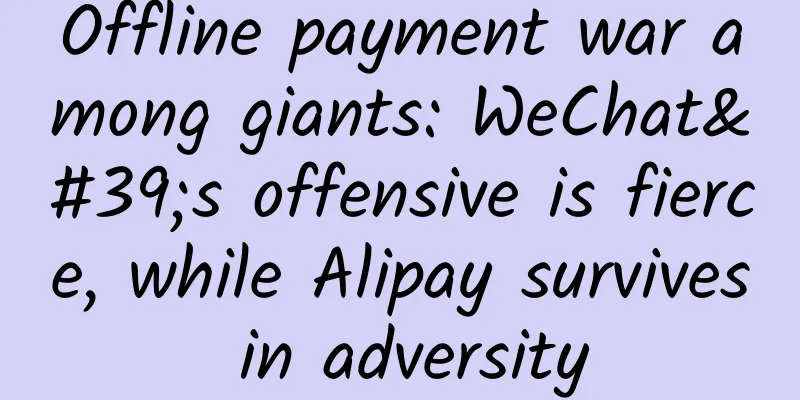Offline payment war among giants: WeChat's offensive is fierce, while Alipay survives in adversity

|
Under the fierce attack of WeChat for two consecutive years, Alipay, which was once in disarray, began to survive in 2017. "If Alipay's offline payment does not reach the target in 2017, all business units of Ant Financial will fail the year-end assessment." Yuan Leiming, vice president of Ant Financial, revealed to reporters that performance linkage is to ensure that the resources of the entire group are allocated to offline payment. Chen Liang, vice president of Ant Financial, believes that these changes are not due to pressure from competitors, but rather that Alipay has become more relaxed since the Spring Festival in early 2017. "After the 'Circle Incident', we have already reached the bottom, what else can we do?" Chen Liang said that he does not think that a red cloth tied on the head can defeat anyone, on the contrary, serving merchants and consumers well in a relaxed state is the fundamental reason for these changes.
Three years ago, Alipay firmly occupied the top spot in China's third-party payment, but during the Spring Festival of 2014, WeChat opened the door to mobile payment through red envelopes. Faced with WeChat, an ultra-high-frequency APP with nearly 1 billion users and an average daily usage time of 9 hours, the once arrogant Alipay had a hard time coping. In the market share increase and decrease in 2015 and 2016, although the mainstream view is that the success of WeChat payment is due to the high-frequency attribute brought by social networking, Alipay believes that the more important factor is that it made a mistake. "Alipay has been plagued by two misconceptions in the past two years: one is that 'pure payment is worthless', and the other is that 'high frequency beats low frequency'. This has led to many wrong decisions, such as positioning problems with word-of-mouth, pursuing user retention time, and ignoring small and micro businesses." An Ant Financial executive told reporters, "These have all changed in 2017." In the past, Alipay lost a large part of its market share due to insufficient coverage of small and micro businesses. "In 2017, Alipay's marketing expenses increased more than 10 times, and the money was mainly used to expand offline, and the main product was the cash code." A market analyst said that the cash code is mainly aimed at small and micro businesses and is known as the product with the highest entry threshold in the history of Alibaba. In the second quarter of 2017, Alipay's market share rebounded. According to iResearch, Alipay's share increased from 54% in the first quarter to 54.5% in the second quarter; Tenpay, the payment service provider behind WeChat Pay, fell from 40% in the previous quarter to 39.8% on a quarter-on-quarter basis. Although the growth of 0.5% may not seem like much, for a company of this size, the absolute value of the increase is very significant. For Alipay and WeChat, the reason why they must win the offline mobile payment war is because of its huge entry significance. Alipay's market share is of great significance to Ant Financial. In September 2016, Liang Xiangyi, head of communications and Internet industry research at Lyon Securities in Hong Kong, announced the valuation model for Ant Financial. Of the total valuation of up to US$75 billion, 67% comes from Alipay. WeChat’s Quick Attack and Alipay’s Mistakes In the first half of the mobile payment battle, the general view attributed the main reason for Alipay's failure to the social stickiness of WeChat, but the reporter interviewed many industry insiders, who agreed that Alipay's mistakes were mainly its own. “From an internal perspective, the two mistakes that had the greatest impact on Alipay were the positioning of word-of-mouth and the development of social networking, which reflected Alipay’s deviation in its understanding of the payment business,” said the Ant executive. Although WeChat Pay quickly became popular through the 2014 Spring Festival red envelopes, the money was still idle at the time, and there were no rich offline consumption scenarios. Compared with WeChat's social stickiness, Alipay's slow offline expansion is more fatal. "At that time, WeChat quickly realized that red envelopes were just an online scenario and had to be quickly expanded offline to make it useful." A person from an ISV (software development service provider) company serving WeChat said that Tencent's consistent style is to seek external cooperation and has a weak desire for control. Although there is a problem of loose alliances, the initial speed will be very fast. WeChat has rapidly expanded its agent system and developed merchants through the aggregated payment platform. According to a research report by CICC, agents can receive commissions from the payment fees of the merchants they manage. Usually, WeChat Pay charges a 0.6% fee, returns about 0.3% to the agent and the integration platform, and pays the bank channel fees from the remaining 0.3%. In the early offline expansion, Alipay always wanted to take the lead, mainly through its subsidiary Koubei to independently develop merchants, and agents were only service agencies and did not participate in the service fee sharing. Koubei was merged with Taodiandian and other businesses on the original brand in June 2015, and positioned as a local life service. "Alipay and Koubei were tied together at that time. They required merchants to connect to Alipay by connecting to Koubei, and Koubei did not support WeChat payment." An ISV person said that WeChat payment was in its bonus period at that time, and many merchants were unwilling to give up. Why did Alipay choose to expand through word of mouth? One important reason is to avoid the price war like that between Didi and Kuaidi. "Pure payment can easily fall into the competition of rates. If you want to jump out of the price war, you need to provide value-added services to merchants, so you think of using word of mouth to provide marketing capabilities." An Ant Financial employee said, "But now it seems that this confuses the order of things. Pure payment is the bottom layer, and you need to have the bottom layer before you can provide other value-added services." Koubei not only carries the demand of expanding offline payment, but also carries the demand of providing marketing services to merchants. As a result, it is easy to lose sight of one while focusing on the other. And because Koubei is also an ISV, the relationship between it and other ISVs becomes delicate. The impact of this delicate relationship began to emerge in the second half of 2015. Before Koubei was established, Alipay had vigorously expanded its offline business, promising many merchants zero fees and providing subsidies to some ISVs. For example, in some offline restaurants, consumers paid with Alipay, and the merchants enjoyed zero fees. Alipay also gave a few thousandths of a rebate to the ISVs in this area. But in the second half of 2015, the positioning of Koubei changed, and some of the original promises were suddenly announced to be postponed. The business logic of ISVs is to advance money to merchants first. Since the expectations for subsidies were very high at the beginning, and even some additional benefits were promised to merchants, without sufficient financial buffer time, a large number of affected ISVs were dissatisfied. "This led to a wave of ISVs defecting to WeChat Pay, which accelerated the pace of WeChat's offline expansion." said the above-mentioned ISV person. "At that time, Alipay was trapped in the wrong view that 'pure payment has no value.'" An Alipay employee said that in 2015, many companies such as Meituan and Didi began to consider doing their own payment, and the central bank also issued more than 200 payment licenses. If Alipay is gradually folded by various companies, where is Alipay's survival space? Based on the anxiety about this issue, adjustments were made to the role and positioning of word-of-mouth, which led to conflicts with ISVs on fee policies. "From another perspective, this is a direct collision between the Internet industry, which is characterized by rapid changes, and the stable offline business based on trust relationships," said Chen Jianwei, a senior practitioner of mobile payment. He was deeply involved in the creation of China Telecom's Wing Payment and the innovation of China UnionPay's mobile payment business. Internet companies are accustomed to rapid changes and often adjust their corporate structures. But offline business is not like this. A complete upstream and downstream industrial chain connection may be built up by more than ten years of trust. However, the concentration of offline business is not high and it is in a weak position, so Internet companies often pass on their rapidly changing costs to offline, further eroding the profits of offline companies. "Another reason is that Alipay and WeChat have different attitudes towards the issue of secondary clearing. Secondary clearing was in a legal gray area at that time, and Alipay was more conservative, cleaning up a large number of secondary clearing institutions in early 2016. WeChat's strategy is more clever, which is also an important reason why the market share of both parties changed significantly in 2016." said an ISV who requested anonymity. After this turmoil, Alipay's market share has fallen sharply. According to Analysys International data, in 2015, Alipay led the Chinese third-party mobile payment market with 68.4%, and WeChat Pay ranked second with 20.6%. However, in Q2 2016, Alipay's market share fell to 55.4%, while WeChat Pay ranked second with 32.1%. "Alipay was even more anxious in 2016, with mixed opinions internally. They started many products without thinking them through, and the reason for doing so might be just to compare with WeChat," said an Ant Financial employee. There were two factions within Alipay on whether to do social networking. Since Alipay's market share fell sharply in 2016, and offline expansion has been unable to beat WeChat, the voices pushing social networking prevailed. In August 2016, Alipay added the "Friends Circle" function, in September the "Arrival (Find People Nearby)" function, and in November the "Circle" function. Each product has traces of keeping a close eye on WeChat. However, with the outbreak of the "Circles" incident, many vulgar photos filled the "Campus Diary" and "White-collar Diary" communities of this social product, and Alipay was nicknamed "payment pimp" by users. Subsequently, Ant Financial Chairman Peng Lei issued an apology letter, and Alipay gave up social networking and fell into reflection. "The tuition for these mistakes is very expensive." The Ant Financial person said, but he believes that these tuition fees are worth it, especially the reflection on the adjustments before and after word of mouth, which has made Alipay no longer reject becoming a pure payment tool, no longer deliberately pursue APP opening rate, and word of mouth has returned to its positioning as a marketing service. After a series of strategic meetings with the theme of reflection and the reform of the class committee system at the end of 2016, Alipay began to slowly relax. Starting with the Spring Festival red envelope project, Alipay no longer focused on data results, but just wanted to "return the Jingyefu owed to everyone in 2016 to users." Then in February 2017, it launched the "Cash Collection Code" and significantly increased budget investment, most of which was used to cover small and micro merchants with the Cash Collection Code. Alipay’s counterattack and WeChat’s anxiety A merchant survey report is said to have helped Ant Financial find its direction. After proposing to build a "cashless society" instead of keeping a close eye on its competitors, Alipay has put more energy into studying merchants and understanding users. The survey report shows that Alipay has a good coverage rate in large merchants such as McDonald's, KFC, 7-11 convenience stores, etc. Users generally complain that many street shops, small bars, and roadside breakfast stalls do not support Alipay payments. But the daily turnover of 20 pancake stalls may not be less than that of a KFC store. In January 2017, Alipay established a mobile payment division to promote small and micro businesses where Alipay was weak. Yuan Leiming believes that the most pressing issue of Alipay's merchant coverage needs to be resolved first, as the threshold for using Alipay was too high. In first-tier cities, the penetration rate of mobile payments has reached over 60%. However, among the middle-aged and elderly groups and small and micro businesses, many people are not familiar with Alipay. This is the world of WeChat Pay. Almost all roadside snack shops use WeChat QR codes printed by the merchants themselves. According to Yuan Leiming, Alipay mainly promoted the payment code in 2017. Users do not need to have an Alipay account. As long as they have a bank account and link their mobile phone, they can generate an Alipay QR code and mail it to the merchant via EMS. In the past, you had to download the Alipay APP first, then bind the card and authenticate, but the Alipay APP is not popular among these merchants. In fact, the payment code was developed in 2016, and the product manager at that time also contacted the senior executives of Ant Financial, but for various reasons, this product was not taken seriously within the Ant Financial system. "At that time, I thought that although this product was good, it was too difficult to promote," said Chen Liang. In the first half of 2017, Alipay sent out 33 million QR codes, and the express delivery costs were high, which caused controversy within Alipay. "Why do we need to print and send QR codes in a unified way? This centralized operation goes against the business logic of the Internet," said an Ant Financial employee. These internal debates show that this product is still under a lot of pressure, because it is an idea that still needs to be verified. However, according to Yuan Leiming's idea, one logic of the Internet is decentralization, such as WeChat public accounts and Weibo, but Toutiao has also succeeded with centralized push. For Alipay, which does not have social genes, it is inevitable that it will try to take the path of standardization. Offline business formats are indeed very different from online. According to the general logic of Internet companies: if you capture 20% of the top customers, you can solve 80% of the market share. Extending to the mobile payment industry, that is to serve the 20% of the top merchants well, and provide an open platform for the remaining 80%, and self-service signing is enough. But the offline business format is long-tail, not as obvious as the Matthew effect online. Offline is based on physical outlets, and its scale has a natural ceiling, so only the top users and the top 10% of merchants are captured, and their transaction volume may only account for 20%-30% of the total. The logic that has been verified on the Internet may not be universal offline. Alipay did not follow Koubei's business structure design, but divided its business lines according to payment needs. The difference is that Koubei is based on marketing positioning, taking into account both online and offline, and has always been divided vertically by industry, such as catering, beauty, etc., which leads Koubei to pay more attention to the top merchants with high turnover. The mobile payment division is divided horizontally according to the level of payment needs, such as large merchants with marketing needs, medium-sized merchants with lending and insurance needs, and small and micro merchants with only payment needs. "There was no special department to look at offline payments before, which was also a mistake." Yuan Leiming said. "In 2017, the payment code greatly increased the coverage of Alipay for small and micro merchants, but Alipay also paid a lot of market costs." Du Mengfei, founder of provincial agent Chuangjiang Technology, said that Alipay's reward coefficient is low in areas with high coverage, and high in areas with low coverage. The incentive is 9 yuan per transaction in areas with high incentives and 2 yuan per transaction in areas with low incentives. A new merchant can receive up to 60 incentives per month. Merchants who use the payment code will be exempt from handling fees for withdrawals until March 2021. "According to the data, the payment code has led to a significant increase in personal transfer transactions on Alipay," said Ma Tao, an Internet finance analyst at Analysys International. He believes this is the main reason for the acceleration of Alipay's offline business in the first half of 2017. "WeChat's growth was natural in the first half of 2017," said a market researcher. According to Tencent's Q3 2017 financial report, Tencent's payment-related services and cloud service revenue increased by 143% year-on-year to RMB 12.044 billion, and the number of offline payment transactions increased by 280% year-on-year. Tencent Chairman Ma Huateng announced at the WeChat 2016 Annual Meeting that WeChat Pay's offline market share has surpassed Alipay. "In the past, WeChat has occupied high-frequency scenarios such as convenience stores, supermarkets, and restaurants offline. In 2017, WeChat Pay combined mini-programs to build an offline ecosystem on the one hand, and supported Meituan to build its reputation on the other hand," said a person who has business dealings with WeChat Pay. WeChat's strategy in the second half of 2017 is to directly connect offline KA (key) merchants with WeChat; for middle-tier merchants, by supporting Meituan, it will compete with word-of-mouth. Meituan will connect merchants in many industries at zero fees; small merchants will be handed over to ISVs. But WeChat's policy is not absolute and has a certain degree of flexibility. In 2017, WeChat's main focus was on promoting mini-programs, hoping to expand more landing scenarios through mini-programs. For WeChat Pay, 2017 was mainly in the transportation field. In November 2017, WeChat released the Guangzhou Metro QR code, which was Tencent's first mobile payment system to access the subway field. Alipay is now laying out the Beijing subway system. More importantly, Tencent also accessed the 12306 railway ticketing platform in November, which was previously the "territory" of Alipay. "Both parties were particularly aggressive in trying to get market share data in 2017." The above-mentioned market analyst said that since the two companies have different statistical calibers, such as whether redemptions of wealth management products are included, whether virtual account transfers of red envelope products are included, etc., both parties increased the transaction volume based on their own advantages. Although Alipay has increased its offline payment market share through the payment code, the concern is whether these small and micro businesses can really generate enough revenue in the future. "In the past, no one provided value-added services to these small and micro businesses because their revenue was too small and the probability of closing the store was very high," said Chen Jianwei. "Due to the lack of technical support, WeChat used to let small stores apply for it themselves, and it was only a pure payment or transfer business. Alipay invested a lot of money and resources in 2017 and deployed a huge amount of volume. This tactic is indeed beyond everyone's imagination, and its difficulty is also beyond imagination." "Covering more B-end merchants and increasing the penetration rate of C-end users is the goal of Alipay in 2017." Yuan Leiming said that the product lines of each business unit need to be customized for the offline market, and the linkage with the year-end assessment ensures smooth internal coordination. Using the "multi-dimensional" financial services to beat the "high frequency" of WeChat has also become the focus of Alipay in 2017. For merchants, Ant Financial launched Yu Li Bao, which is also a money fund product of Tianhong Fund like Yu'e Bao and is sold by MyBank. MyBank also launched "MyBank Loan", a credit loan product for merchants, as well as "More Collection, More Loans", "More Collection, More Insurance" and other products based on payment data for merchants. "Compared to Alipay's advantages in financial services, WeChat Pay's depth is relatively limited." Chen Jianwei said that WeChat Pay is positioned as a part of the WeChat ecosystem. For the sake of the overall WeChat ecosystem, it can enjoy dividends, but it must also bear the corresponding ceiling. As the Chinese people's demand for financial services sprouts day by day, Alipay is currently the only APP that can provide inclusive financial services to individual users based on a large number of users. WeChat's layout in the financial field, such as insurance and Weilidai, is still too scattered, and it is difficult to form a unified position to compete with Alipay. Among the banks, China Merchants Bank has done better, but the scale of its customer base is not as large as Alipay. CICC analyst Huang Jie believes in a research report that Alipay's layout in financial management applications (Jiebei/Huabei/Ant Jubao/Zhima Credit/stocks/insurance, etc.) is stronger than WeChat (WeChat Credit + WeBank). WeChat's shortcomings in its financial business layout make its ability to transform from payment to other financial businesses slightly insufficient. For example, Alipay Huabei/Jiebei has over 100 million users, while WeBank has over 20 million; Yu'ebao has over 300 million active users, and Tencent WeBank has over 20 million. In mid-2017, Alipay's market share rebounded, which means that the mobile payment war has entered the second half. In the first half, everyone was scrambling for users, and WeChat, with its strong social relationship chain, had an advantage in this stage. "If Alipay's market share fell by 50% in 2017, it would be dangerous, but this setback did not happen." Chen Jianwei said, "The core capability of the next market stage is financial services." "In 2016, WeChat Pay said internally that the battle would be over within six months," said a person close to WeChat. Just like Alipay underestimated WeChat Pay back then, WeChat also underestimated Alipay this time. |
<<: How programmers play mobile games, go play now~
>>: How to develop a desktop app using Electron
Recommend
Learn about OCPX smart bidding models such as Toutiao and Guangdiantong in 5 minutes
I changed batches of materials, but there was no ...
WeChat supports mobile phone number transfer without adding friends
When using a bank card APP to transfer money, you...
A complete guide to short video operations!
I believe that many of my friends in self-media a...
Event Operation: How to plan a complete event? (Attached with mind map)
The planning document is clearly well-written, bu...
A new round of internal testing of WeChat’s exclusive input method: preventing eavesdropping and protecting privacy
[[434938]] As early as the beginning of this year...
How did two tech novices sell their e-commerce startup for millions of dollars?
[[145849]] In October 2013, my partner and I were...
Who is most likely to become the fourth pole of China's Internet?
[[157689]] BAT has already occupied an absolutely...
Four weapons for operating community products: vests, topics, points, and messages
We said that to design a community you need to: f...
WeChat circle application template, how to write the reason for applying for WeChat circle?
WeChat Circles is a new product launched by WeCha...
Why did the Samsung Galaxy Fold fail? Well-known disassembly agency iFixit gives their opinion
Samsung's Galaxy Fold foldable phone could no...
Lhasa Mini Program Production Company, how much does it cost to produce a supplement mini program?
There are two types of Lhasa Supplements WeChat M...
The "main structure" of short video fan-increasing skills
Like speeches and articles, the structure of shor...
2022 Infant and Child Care Expenses Deduction Standards: Can newborns receive special personal income tax deductions?
During the 2022 National People's Congress an...
Why doesn’t Durex pursue Wang Baoqiang?
These two days, Everyone was shocked by a breakin...
In-depth analysis of KOL operations from 0 to 1!
What I talk about most with friends recently is K...









